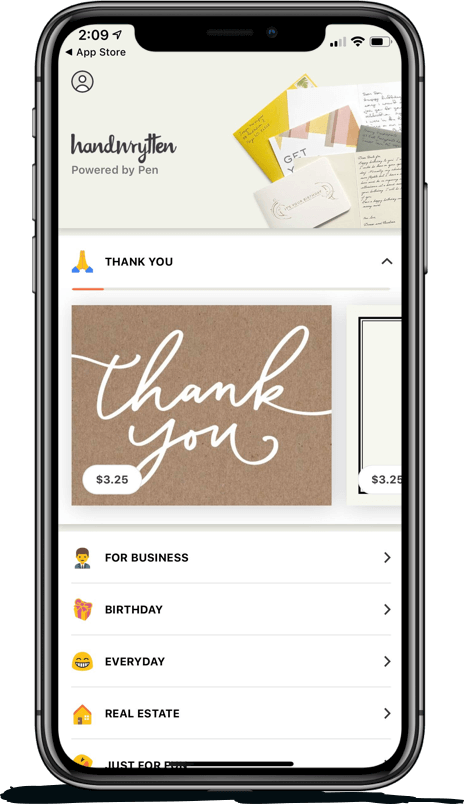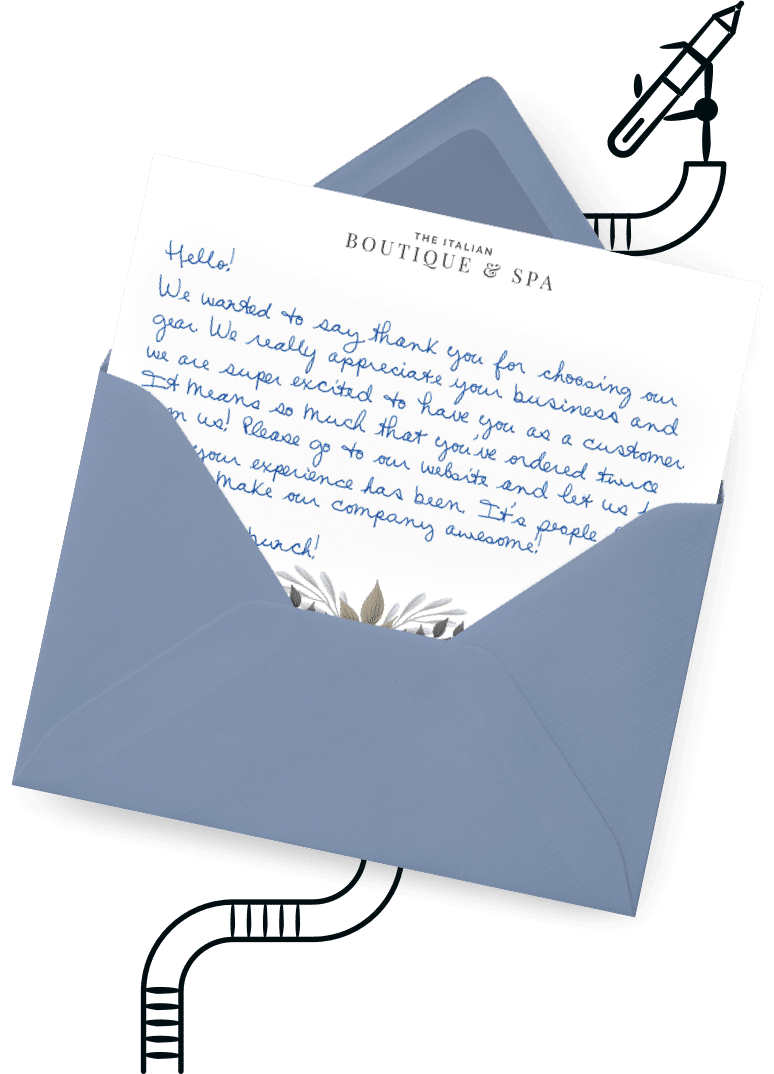
9280 S. Kyrene Rd.
Suite 134
Tempe, AZ 85284
Phone: +1 (888) 284-5197
Email: contact@handwrytten.com



You have been subscribed. Thank you!


Since the COVID-19 pandemic, the world has shifted into a completely new pattern. Ordering groceries with the click of a button has never been easier, and dating apps continue to rise in popularity. But one thing that people don’t tend to consider is how customer experience has changed in recent times.
Previously, when a customer was unsatisfied with a product or their overall customer journey, there was not much to be done. The associated brand was the top one on the market, with few competitors to offer an alternative. Nowadays, there are hundreds of brands offering the same type of product.
Think about athletic wear brands, for example. Off the top of your head, you can probably name at least five – Adidas, Puma, Under Armor, Nike, New Balance, Fabletics, lululemon, and more.
The point is, markets are currently densely entrenched with competition, so there needs to be a way to establish a competitive edge. And the numbers back this up; a whopping 86% of buyers are more inclined to pay more for something when they simultaneously receive a great customer experience.
Not only that, but users who had a poor customer experience are 88% less likely to continue to be repeat customers. That is a staggeringly high number – if a consumer is dissatisfied during their transaction, sure, they made the first purchase. But repeat customers are infinitely more profitable for a business – they cost less to make another purchase, they refer friends to your brand and other benefits.
Assuming you already know what customer experience is, let’s start from the very top of your business.
Truly customer-centric organizations are customer focused starting with the customer service representatives, all the way up to high-level executives. Everyone is part of the support team in some way. Just because someone has a title with the word ‘Chief’ in it doesn’t mean they are excluded from thinking about the customers as more than dollar signs; if that mindset is in play at any level, the trickle-down effects are impossible to quantify.
Disney is a well-renowned organization both for the experiences they provide and the customer-centric culture they have at the heart of its brand. Each employee is taught their Compass Model, a way to focus on customer journeys.
When this model is at the forefront of every employee’s mind in a business, it changes a few things. While it technically raises the bar significantly for customer expectations, it also leads to great customer service that, when done properly, will help boost customer retention and loyalty in the long term, making a lot more happy customers.
Your brand cannot turn into Disney overnight, but by understanding that the entire company should have the same customer-driven mindset to achieve the greatest degree of success possible, you can take your brand to new heights.
Omnichannel is a weird word, and it may sound a bit like multichannel at first. But, that is not the case; while multichannel refers to several individual channels, like phone and email, omnichannel discusses a seamless experience that links the two. Take this example.
Let’s say you just got off the phone with customer support and were given a case number to look up your case at a later time. But when you go to the brand’s website to find out what kind of notes were taken by the service rep, you find that there is no way to look at your case. This is an example of a multichannel experience.
An omnichannel experience would be the case where after you receive your case number, you can go to the website and see a field to put in your case number, where you subsequently get the information you’re looking for. Even further than that, you go into the phone app and see that the case is automatically linked to your account.
While both omnichannel and multichannel experiences are related to customer experiences, omnichannel experience provides a fluid transition between platforms that makes it easy for the consumer to sit back and enjoy intuitive interaction.
It should be obvious by now – if you don’t go end-to-end and look at each step of the customer journey to determine where any pitfalls or sticking points may be, it will be extremely difficult to tell if you are providing more of an omnichannel or more of a multichannel experience.
Going step by step, in the customer’s shoes, and seeing how customers interact when purchasing your product, like looking in the app, browsing the website, or asking a question, will give you information about how to improve customer experience. Once you are at the point where each of your channels is interconnected, you can rest assured knowing your omnichannel strategy will pay off.
This is one of the less impactful suggestions on our list, but it is still a noteworthy addition to a brand that offers none of these options. Self-service options are tools provided to your customers that allow them to get information about your brand, products, and any other questions they may have without having to interact with you directly. A few examples include:
All of these options require some time and money investments to provide value to the customer, but after they have been created, maintaining them is not too difficult. But the benefit they provide is significant – if you can provide answers to 90% of customer questions in FAQ pages, knowledge bases, or forums, and can answer 8% through AI bots, your customer service team will be able to take on different roles to provide benefit to your company in different ways, propelling you forward.
Before we move on, one strategy that we don’t see enough of is transparent questions and answers. Imagine if your favorite brand had a database where every single question and answer on the phone, online, or through whatever channel, was listed; wouldn’t that be extremely convenient?
Of course, setting up this sort of database would not be simple, but the value it would provide would be immense: any customer could go to this database, search a keyword or question, and immediately see if anyone else ever had that same issue. And if not, then after they ask it themselves, no one else will ever need to ask again, because the database will already have the answer.
This sort of transparent, honest feedback about your brand helps to build trust in what you can provide.
This goes hand-in-hand with having high-level executives on the same page as customer service representatives, but only really discussing those lower on the ladder.
When you give freedom to your employees, those who interact with customers multiple times per day and understand how customers feel, they can provide a customer experience beyond the standard. In this case, freedom simply means the ability to do what they need to do to keep the customer satisfied.
Say that you are out at a restaurant and order a steak cooked medium. When the food finally comes, you see that the steak is completely overcooked and tough and ask the waiter if they can remake it. The waiter was taught by upper-level staff that taking food back was bad for business and would decrease profits, so he says no. But you, the customer, are left with a sour taste in your mouth.
This is not the standard in most restaurants – 99 times out of 100, waiters will happily take the steak back, relay the message back to the chefs, and have them remake it. Sometimes they will even take the item off of the bill, or give you a complimentary dessert. But that is only because they are given the freedom to pass judgment on situations that cannot be predicted.
Let your employees do whatever they can to make the customer happy (as long as it doesn’t make you go bankrupt). It pays dividends to spend a little bit of extra money to make the customer feel more satisfied, and when the entire company is on board with this philosophy, it makes pivoting so much simpler.
Do you want your customers to feel heard or welcomed when using your website or reading an email, or is the objective to provide information while linking back to your product to discuss its benefits?
Once you know what you want your customers to expect from your brand, creating an overall brand message should be rather intuitive: make it what you want your brand to be seen as. Keeping in mind your current consumer base to make sure that it doesn’t push people away is important too, but staying authentic to your brand will ultimately bring you more fulfillment as a business owner and likely more loyal customers.
But keeping your brand message clear is a bit different than simply developing a brand message. To keep your brand message clear, you must realize that on every platform your company exists on – LinkedIn, Instagram, Facebook, website, and email – the sentiment must always be the same.
By unifying how your brand appears online, not only will this track well with consumers, but it will also show that you’ve taken the time and care to make sure that at all levels of your messaging, you have thought through how your brand should appear.
Look at us, for example. We’ve integrated with multiple channels – Facebook, Twitter, LinkedIn, Instagram, Pinterest, and YouTube – and our messaging is consistent throughout. Similar font styles, color choices, and phrasing are all thought of to be important in how we present ourselves to the community and are one reason we pride ourselves on being the best robot handwritten card service out there.
Even further than that, our core brand message – “You type. We write.” – is inextricably linked through all of these various channels.
The customer life cycle is a rarely talked about topic that needs a lot more discussion. By looking at the life cycle, you can nip a customer’s problem in the bud as soon as it happens to help you improve the customer experience.
The life cycle of a customer refers to the entire customer experience, starting with when they become aware of the existence of the product, and closing with them becoming a loyal customer. Employees on a marketing team or sales team may recognize this as a sales funnel.
Defined by Hubspot, the five stages of the customer life cycle are:
Reach occurs when the customer has a problem that they want to solve; this is the opportunity for you to ‘reach’ a potential customer through different means like social media marketing or Google Ads.
The customer has entered the funnel. At this stage, most customers expect to find informational content or a few tips to convince them that your product or service is the way to go.
This should be a pretty self-explanatory stage of the process; the customer has now made a purchase and is now officially a customer. Many brands find it beneficial to send thank you emails to build rapport, and for those in service-based industries, letters welcoming their new clients may be extra potent.
Customer retention is a bit different from the first three stages; here, you have to focus on continuing to stay in touch with them to make sure that they are enjoying your product and potentially offering them a different product. You can do things like taking surveys to gather data on how to improve your services for the future, or if your retention is lacking, send letters to win them back.
At this point, the customer is loyal to your brand and has made multiple purchases. If their loyalty goes deep enough, they may even post on social media networks about their love for your product, or write product reviews that you ask for.
There isn’t a difficult part of engaging with your customers to note.
In Reach, you are already engaging with your customer through how they discover your brand.
In Acquisition, you just need to make sure that the information you provide directly to the customer is quality, leaving them feeling satisfied and without questions. This will ultimately lead to them converting.
In Conversion, sending your new customers emails thanking them for their purchase, or even sending them a handwritten note if you have the capital to spend would lead to an increased chance of Retention.
For Retention, reach out to past customers every so often to check in with how they are doing – are they liking the product? Do they think there could be improvements somewhere? Asking questions like these will make the buyer feel heard and leave them desiring to be understood.
And lastly, beyond retaining your customers, to develop Loyalty, you must have already nurtured the four previous stages to offer the customer a brand experience like no other they’ve experienced before. Reaching out to them at this stage can only help to make them more loyal.
Looking at your customer experience management in this way will help you not only understand customers better, but it will allow you to glean customer experience data to provide you with more ways to enhance experience.
This ties in with paying attention to the customer’s life cycle, but collecting data throughout various points of the customer’s journey.
Do you have a ton of website traffic with the majority of it being attributed to social media advertising? Or is it organic search that is driving the vast majority of potential leads to your product pages? If it is either of these, adjusting your Reach and Acquisition would be the logical next step to ensure that are you getting the best business outcomes.
But if customers get to your website and look at your product but don’t convert, this is also valuable information. They liked your brand and product enough to visit your website – but something didn’t resonate with them, enough that they didn’t convert. This is a fantastic opportunity to think about different ways to enhance customer experience.
Most marketers recommend creating customer journey maps before implementing any of the previous techniques, but in our opinion, it makes more sense to do it after. Why?
When the entirety of a company is on board with a similar mindset, your goals and objectives will fall into place effortlessly. You are now one unified task force, and when you take into account customer feedback, you will begin to intuitively understand the customer journey.
But now that you have implemented these mindsets and ideas into the stitching of your brand, it is important to focus on optimizing what you already have. Sure, there may be certain creative campaigns that may not work out, but in general, iterating upon what you already have to keep your brand true to itself should be your objective.
Optimizing the customer journey is a matter of taking into account what has already been changed and how then mapping out the path of previous customers based on their feedback. Once you have done this, you can understand what parts of their journey led to them feeling disgruntled or irritated with your brand, or what parts led to them developing deep loyalty to it.
This primarily involves using the data that was mentioned above to inform your decisions.
For example, imagine that the customer journey is a sales funnel (which, it is). You’ve successfully developed content and advertising to Reach customers and have also Acquired them, meaning they are interested in your product. But you notice using data from Google Analytics that a significant amount of buyers drop off at your checkout page; what gives?
You realize that there are significant backend issues when transitioning from your website to the checkout page, with snail-pace loading times and an overall fragmented website design.
The point is, without having looked into the data provided to you, it is extremely difficult to get an idea of the actual customer experience that people receive. With most people tracking their metrics through Google Analytics in the modern day, learning how to set up funnels will make your life infinitely easier.
Improving your customer experience doesn’t stop after you’ve converted them; to offer a positive customer experience, you always need to be providing as much information as possible to customers while also offering a frictionless platform to do so.
In a sense, if you can standardize the minimum service your customer service representatives need to provide for past and new customers, you will eliminate potential liability. Providing the best customer service possible will allow your brand to circumvent the issue entirely.
As the customer, when a company gives you poor customer service you will be significantly less likely to buy a product or even continue using that brand in the future.
Say, for example, that you used the chat function on a website to speak with a customer service rep. After typing a few messages back and forth, you realize that you are speaking to an underdeveloped chatbot who doesn’t have very fleshed-out responses. You try to ask it a basic question like “how long does it take to ship an item?” to which it responds “Rephrase”.
The lack of human touch and complete lack of development of ideas will likely leave you feeling dissatisfied, and unlikely to continue purchasing from this brand.
On the opposite side of things, when you can easily acquire the information you need from a company’s website or their customer service makes it easy for you to get the answers you need, you will be left satisfied, or at least feel that they have put effort into making you feel heard.
At the core of human psychology, feeling heard, like somebody just understands you, is what we all want. That is one of the main reasons one of the best marketing tactics is to relate to the customer: when a customer feels understood, they will want to become a repeat customer, helping to increase customer loyalty.
Now that you’ve collected data at different points of the customer’s journey, and hopefully collected feedback in some form, you can actualize the benefit of this information by putting it into play. Every bit of information you can acquire about the customer experience you provide from customers can only benefit you, so leave no stone unturned.
If you are collecting data on specific metrics on your social media platforms and your website, like clickthrough rate, scroll depth, total traffic, and conversions per click, take note of how different advertisements or different individual webpages perform compared to the average. Are there standout Instagram ads that lead to higher conversions than normal? Do Facebook ads statistically perform worse on average?
These things are pieces of ‘feedback’ that are not offered up to you by the customer. Actual feedback would include product reviews, survey responses, customers reaching out to critique or suggest changes to a product, or even chat logs saved by a chatbot.
Looking into these pieces of feedback can be even more beneficial than framing your marketing around what is working; when you see what is turning your customers away from you, you can more easily understand where you are messing up and how you can better connect to your target audience.
There are hundreds of ‘strategies’ that exist out there to educate you on how to improve customer experience, but most of them can be encompassed in these ten strategic mindsets that will inevitably help your brand to target customer needs better:
If you’ve made it this far, thank you for reading this article in its entirety. Our desire to maximize customer satisfaction while simultaneously sharing the knowledge that we have to help other professionals become better has helped us to develop a few tools to help you level up your customer experience.
Dissimilar to email or traditional print marketing, handwritten notes have an 80% open rate. With the hugely increased likelihood of opening comes significantly more potential to have an impact on the customer’s purchasing decisions.
Along with these notes, product inserts or gift cards can automatically be included to increase mail open rate and client retention. If you received a gift card or a one-serving coffee pouch with a handwritten card, don’t you think you would pay a bit more attention to that business?
Customer experience teams can even stay in contact and on top of past and present buyers’ minds by sending personalized, pen-written birthday wishes and even ‘happy holidays‘ cards. This will leave a statement that very few marketers can.
Check out our services or other pieces of content like writing a great closing for your card to help lock in more leads.
The three main parts of customer experience are quality, customer satisfaction, and a company-wide culture. An organization that places these three tenets as its core focus will almost undoubtedly create a good customer experience.
As aforementioned far above, a significant amount of customers will move away from your product if they are dissatisfied with the customer experience that they receive; taking the time to think about the experience you currently provide and iterating upon it will allow you to reap immeasurable benefits.
A great customer experience strategy appears when the majority of customers are satisfied when there is an intersection of product satisfaction and appreciation of customer service. This means that to create a great customer experience, a CX designer should focus on listening to customer feedback to enhance the product design, as well as make sure that all employees prioritize delivering an exceptional experience.


Scale your handwritten outreach, creating positive impressions and long lasting bond.
Sign Up Today!


Over 100 designs to choose from or design your own. Our online card customizer makes it simple.
Check Out Our Cards!





